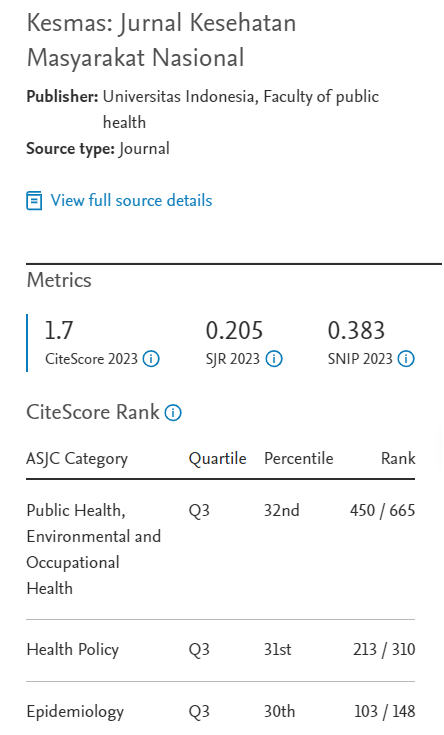Abstract
Masalah kaki diabetik di Indonesia masih merupakan masalah besar dan masih memerlukan perhatian yang optimal. Edukasi perawatan kaki adalah salah satu upaya yang harus dilakukan dalam mencegah masalah kaki untuk pasien diabetes melitus. Penelitian ini bertujuan untuk menganalisis efektivitas program pendidikan perawatan kaki dalam meningkatkan pengetahuan, efikasi diri, dan perilaku perawatan kaki pasien diabetes di wilayah Banjarbaru. Jenis penelitian yang digunakan adalah quasi experimental dengan prepost test, dilakukan di puskesmas wilayah Banjarbaru tahun 2013. Kelompok intervensi diberikan program pendidikan perawatan kaki. Sampel berjumlah 48 pasien (32 orang kelompok intervensi dan 16 orang kelompok kontrol) menggunakan teknik purposive sampling. Variabel yang diukur adalah pengetahuan, efikasi diri, dan perilaku perawatan kaki pasien diabetes melitus. Perlakuan yang diberikan pada responden berupa pendidikan kesehatan tentang perawatan kaki sebanyak dua kali. Setiap variabel diukur dua kali sebelum dan setelah intervensi. Uji pengetahuan diukur menggunakan Diabetic Foot Care Knowledge Questionnaire, efikasi diri diukur menggunakan Foot Care Confident Scale Self-Efficacy, dan perilaku perawatan kaki dinilai menggunakan Behavior Foot Care Questionnaire. Analisis data menggunakan Manova. Hasil penelitian menunjukkan perbedaan yang signifikan pada tingkat pengetahuan (nilai p = 0,001), efikasi diri (nilai p = 0,000) dan perilaku perawatan kaki (nilai p = 0,000) sebelum dan setelah intervensi. Diabetic foot problem in Indonesia remains a big problem and still needs an optimum concern. Foot care education is one of efforts that must be performed to prevent foot problem among diabetes mellitus patients. This study aimed to analyze effectivity of foot care education program in improving knowledge, self-efficacy and foot care behavior of diabetes patients in Banjarbaru. This study was quasi experimental with prepost test as conducted at primary health care in Banjarbaru in 2013. Foot care education program was provided to intervention group. Samples were 48 patients (32 persons in intervension group and 16 persons in control group) using purposive sampling technique. Variables measured were knowledge, self-efficacy and foot care behavior of diabetes mellitus patients. Intervension provided on respondents was in form of health education concerning foot care for twice. Every variable was measured twice before and after intervension. Knowledge test was measured using Diabetic Foot Care Knowledge Questionnaire, self-efficacy was measured by using Foot Care Confident Scale Self-Efficacy and foot care behavior was assessed using Behavior Foot Care Questionnaire. Data analysis used Manova. Results showed significant differences on knowledge level (p value = 0.001), self-efficacy (p value = 0.000) and foot care behavior (p value = 0.000) before and after intervension.
References
1. Robbins JM, Strauss G, Aron D, Long J, Kuba J, Kaplan Y. Mortality rates and diabetic foot ulcers: is it time to communicate mortality risk to patients with diabetic foot ulceration?. Journal of American Podiatric Medical Association. 2008; 98 (6): 489-94.
2. Perkumoulan Endrokinologi Indonesia. Modul pelatihan penatalaksanaan kaki diabetik bagi dokter spesialis penyakit dalam. Jakarta: Perkeni; 2009.
3. Goodridge D, Trepman E, Embil JD, Daughty D. Health-related quality of life in diabetik patients with foot ulcers: literature review. Journal of Wound, OStomy, and Continence Nursing. 2005; 32(6): 368-77.
4. Frykberg RG, Zgonis T, Armstrong DG, Driver VR, Giurini JM, Kravitz SR, et al. Diabetic foot disorder: a clinical practice guideline. The Journal of Foot & Ankle Surgery. 2006; 45(5): 2 -3.
5. Singh N, Armstrong DG, Lipsky BA. Preventive foot ulcer in patients with diabetes. The Journal of American Medical Association. 2005 [ cited 12 Aug 2008]; 293 (2): 217-28. Available from: http://jama.amaassn.org/cgi/content/full/293/2/217.
6. Pollock RD, Unwin NC, Connoly V. Knowledge and practice of foot car in people with diabetes. Diabetes Research and Clinical Practice. 2004; 64: 117-22.
7. Sloan H. Developing and testing of the foot care confident scale. Jurnal of Nursing Measurement. 2002; 10: 207-18.
8. Vileikyte L, Gonzales J, Leventhal H, Peyrot M, Rubin R, Garoww A, et al. Patient interpretation of neuropathy (PIN) questioner: an instrument for assessment of cognitive and emotional factor associated foot self care. Diabetes Care. 2006; 29(12): 2617-24.
9. Bastabel S. Prinsip-prinsip pengajaran dan pembelajaran. Jakarta: EGC; 2002.
10. Corbett CF. A randomised pilot study of improving foot care in home health patients with diabetes. Diabetes Educator. 2003; 29: 273-82.
11. Valk GD, Kreigsman DMW, Assendelf WJJ. Patient education for preventing diabetic foot ulceration. Cochrane Database of Systemic Reviews. 2005; 25 (1): 1-43.
12. Vatankhah N, Khamseh ME, Naudeh YJ, Aghili R, Baradaran HR, Haeri NS. The effectiveness of foot care education on people with type 2 diaetes in Tehran Iran. Primary Care Diabetes. 2009; 3: 73-7.
13. Carson JA, Gillham MB, Kirk LM, Reddy ST, Battles JB. Enhancing self efficacy and patient care with cardiovascular nutrition education. American Journal of Preventive Medical. 2002; 23(4): 296-302.
14. Litzelman DK, Slemenda CW, Langeferd CD, Hays LM, Welch MA, Bild Diane E, et al. Reduction of lower extremity clinical abnormalities in patients with non insulin dependent diabetes mellitus. Annals of Internal Medicine. 1997; 119(1): 36-41.
15. Hasanli Y, Amir F, Utomo W. Hubungan tingkat pengetahuan dan sikap klien diabetes mellitus terhadap perawatan kaki diabetes. Jurnal Keperawatan Profesional Indonesia. 2010; 2(2): 50-5.
16. Perrin BM, Swerissen H, Payne C. The association between foot-care self efficacy beliefs and actual foot-care behaviour in people with peripheral neuropathy: a cross-sectional study. Journal of Foot and Ankle Research. 2009; 2:3.
Recommended Citation
Mahdalena M , Ningsih ES .
Effectivity of Foot Care Education Program in Improving Knowledge, Self-Efficacy and Foot Care Behavior among Diabetes Mellitus Patients in Banjarbaru, Indonesia.
Kesmas.
2016;
11(2):
56-60
DOI: 10.21109/kesmas.v11i2.583
Available at:
https://scholarhub.ui.ac.id/kesmas/vol11/iss2/2
Included in
Biostatistics Commons, Environmental Public Health Commons, Epidemiology Commons, Health Policy Commons, Health Services Research Commons, Nutrition Commons, Occupational Health and Industrial Hygiene Commons, Public Health Education and Promotion Commons, Women's Health Commons







